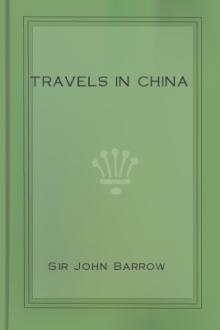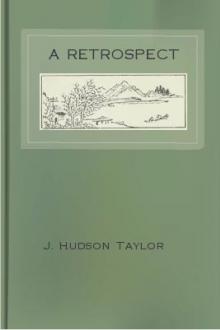Travels in China, Sir John Barrow [phonics readers txt] 📗

- Author: Sir John Barrow
- Performer: -
Book online «Travels in China, Sir John Barrow [phonics readers txt] 📗». Author Sir John Barrow
Consistent with the principle of "taking no thought for the morrow," the priests of Lao-Kung devoted themselves to a state of celibacy, as being more free from cares than the incumbrances which necessarily attend a family connexion; and the better to accomplish this end, they associated in convents. Here they deal out to their votaries the decrees of the oracle agreeably to the rules prescribed by Confucius; and they practice also a number of incantations, magic, invocations of spirits, and other mystical rites that are probably as little understood by themselves as by the gazing multitude. In performing these magic tricks they march in procession round the altar, on which the sacred flame is supposed to be kept perpetually burning, being a composition of wax and tallow mixed up with sandal wood shavings and other perfumes; they chaunt in unison a kind of recitative, and they bow their heads obsequiously every time they pass before the front of the altar. The great Gong is struck at intervals, accompanied by tinkling sounds emitted by gently striking small metal plates suspended in a frame as in the plate of musical instruments. Their temples are crowded with large and monstrous figures, some made of wood, some of stone, and others of baked clay daubed over with paint and varnish, and sometimes gilt. To such figures however they do not seem to pay any kind of homage. They are intended merely to represent the good and evil genii under the various passions to which human nature is liable. The good genii, or pleasing affections, are placed on one side of the temple, and their opposites on the other. Thus the personifications of mirth and melancholy, love and hatred, pleasure and pain, are contrasted together. The conditions of men are also represented, and their figures opposed to one another. In this light at least they appeared to us; though the priest at Tong-tchoo informed us they were intended to pourtray the different characters of the monks that had belonged to the monastery. In some temples also are met with the statues of such Emperors or ministers of state as had shewn themselves favourable to any particular convent. If, for instance, a great man should occupy the apartments of a temple and at his departure leave a considerable sum of money, the priests, out of gratitude, would place his image in a niche of the temple. In looking into one of these edifices a stranger would be apt to conclude that they were Polytheists, which I do not understand to be the case. Like the saints of the Catholics the great Fo, of whom I shall presently speak, with Poo-sa, Shing-moo, and many others, are considered only in the light of agents and intercessors, or as emanations of one creating, destroying, and renovating power, whose good providence has divided itself into a number of attributes for the better government of the universe[45].
Next to this religion of the immortals, was introduced another of nearly the same growth which, from being patronized by the court, soon became no less popular than the former. The priests of Fo, coming by invitation from India, imported with them a great portion of the Hindu mythology, which some learned men have supposed to be the origin from whence the Polytheism of Egypt and Greece had its source; and others the direct contrary. Be that as it may, the affinity seems to be too strong not to ascribe them to a common parent; and the representations and the histories of many of the gods of these nations were imported, in all probability, with the religion of Fo, from India into China. This will better appear by comparing a few as they are observed in the different nations.
The Budha of the Hindus was the son of Ma ya, and one of his epithets is Amita: the Fo of China was the son of Mo-ya, and one of his epithets is Om-e-to; and, in Japan, whose natives are of Chinese origin, the same god Fo is worshipped under the name of Amida. I could neither collect from any of the Chinese what the literal meaning was of Om-e-to, nor could I decypher the characters under which it is written, but it appeared to be used as a common ejaculation on most occasions, just as we Europeans are too apt to make a familiar and impious use of the name of God. Perhaps it might not seem inconsistent in considering it to be derived from the Hindu mystic word Om.
Since the accession of the Tartar princes to the throne of China, the court religion, or at least the Tartar part of the court, which before adhered to the tenets of Confucius, has been that of Fo or Budha. The priests are numerous, mostly dressed in yellow gowns, live in a state of celibacy in large convents or temples, which the Chinese call Poo-ta-la, evidently derived from Budha-laya, or habitation of Budha, this name being adopted by the Tartars, which the Chinese have been under the necessity of following as nearly as their organs of speech would admit. They wear a sort of chapelet round their necks, consisting of a number of beads. In some of their ceremonies they march, like the Tao-tses, in procession round the altar, counting their beads, repeating at every bead Om-e-to-fo, and respectfully bowing the head. The whole string being finished, they chalk up a mark, registering in this manner the number of their ejaculations to Fo. This counting of their beads was one of the ceremonies that very much exasperated the missionaries.
The Ganesa of the Hindus, the Janus of the Romans, and the Men-shin, or guardian spirit of the door of the Chinese, are obviously one and the same deity. Sometimes he is painted with a club in one hand, and a key in the other, representing the protector of the house. On almost every door in China, where the inhabitants profess the religion of Fo, is drawn the figure of Men-shin, or otherwise the two characters of this word, agreeing exactly with what Sir William Jones has observed of the new town of Gayá in Hindostan, "that every new built house, agreeably to an immemorial usage of the Hindus, has the name of Ganésa superscribed on its door: and in the old town his image is placed over the gates of the temples."
The Vishnu of the Hindus, riding on an eagle, and sometimes attended by an eagle, has been considered as the Jupiter of the Greeks; and the Lui-shin of the Chinese, or spirit of thunder, is figured under a man with the beak and talons of an eagle, sometimes surrounded with kettle drums, carrying in one hand a batoon and in the other a flame of fire. The Osiris of the Egyptians, from whence the Greeks had their Jupiter, comes still nearer to the Lui-shin of the Chinese. When represented as the emblem of the sun, he was drawn under the figure of a man with an eagle's beak, carrying in his hand a batoon on which was painted an eye. The ingenious and fertile imagination of the Greeks separated the emblem from the god, and made the bird of prey the attendant of the divinity, which the Egyptians and the Chinese united under one symbol. It is a curious coincidence of opinion, if it be not founded on fact, that the Chinese should assign the same reason for giving an eagle's face to their Lui-shin, that Pliny has for the consecration of that bird to Jupiter, namely, that no instance was ever known of an eagle being destroyed by lightning. The Chinese have also an observation with regard to this bird, which has been made by other nations, and which is, that the eagle, in a thunder storm, always mounts above the clouds.
The Varuna of the Hindus, riding on a fish, the Neptune of the Greeks, and the Chinese Hai-vang, or king of the sea, reposing on the waves, with a fish in his hand, are unquestionably one and the same personage.
The giant Briareus, with his hundred hands, is truly in China of a most stupendous and colossal stature, being commonly from fifty to sixty feet in height, and sometimes as tall as eighty feet. But the largest of all their deities is a woman of the family of Poo-sa[46], apparently a personification of nature. This goddess is modelled in a variety of ways; sometimes she is to be found with four heads, and forty or fifty arms, the heads looking towards the four cardinal points of the compass, and each arm holding some natural product of the earth subservient to the use of man. Sometimes each arm produces several smaller arms, and on the head stands a pyramidal groupe of smaller heads. Van Braam mentions his having seen a statue of this goddess that was ninety feet high, having four heads and forty-four arms. It is no uncommon thing to meet with temples in ruins, in the midst of which these monstrous gods and goddesses are seen entire, exposed to the elements. It seems the inferior temples are generally upheld by the voluntary gifts of the people; and that, whenever any unusual calamity befals a town or village, such as severe famine, epidemic disease, inundations, or the like, whose dire effects cease not on repeated applications to the protecting saint, by way of punishing the gods, they literally pull down the temple over their heads, and leave them sitting in the open air. The grotesque and barbarous manner of representing the manifold powers of nature, or the goddess of nature, by a plurality of heads and hands in one idol, is by no means favourable to the supposition of a refined or superior understanding in the people who adopt them into their religious worship. It can be considered only as a very short step beyond the conceptions of savages, who have no other idea than that of supplying by number, or a repetition of the same thing, what may be wanting in power. The same figure, with numerous arms, appears in the Hindu temples that are excavated out of solid granite mountains, the most ancient and among the most wonderful monuments of art and persevering labour that have hitherto been discovered on the face of the globe, the fountain perhaps from whence the arts, the sciences, and the religious mysteries of the Egyptians and the Greeks derived their origin.
But the most common of all the female deities in China is the Shing-moo, or holy mother, or rather the mother of perfect intelligence[47]. This lady is the exact counterpart of the Indian Ganga or goddess of the river, the Isis of the Egyptians, and the Ceres of the Greeks. Nothing shocked the missionaries so much on their first arrival in China as the image of this lady, in whom they discovered, or thought they discovered, the most striking resemblance to the Virgin Mary. They found her generally shut up with great care in a recess at the back part of the altar, and veiled with a silken screen to hide her from common observation; sometimes with a child in her hand, at other times on her knee, and a glory round her head. On hearing the story of the Shing-moo they were confirmed in this opinion. They were told that she conceived and bore a son while yet a virgin, by eating the flower of the Lien-wha (the Nelumbium) which she found lying upon her clothes on the bank of a river where she was bathing: that, when the time of her gestation was expired, she went to the place where she had picked up the flower and





Comments (0)